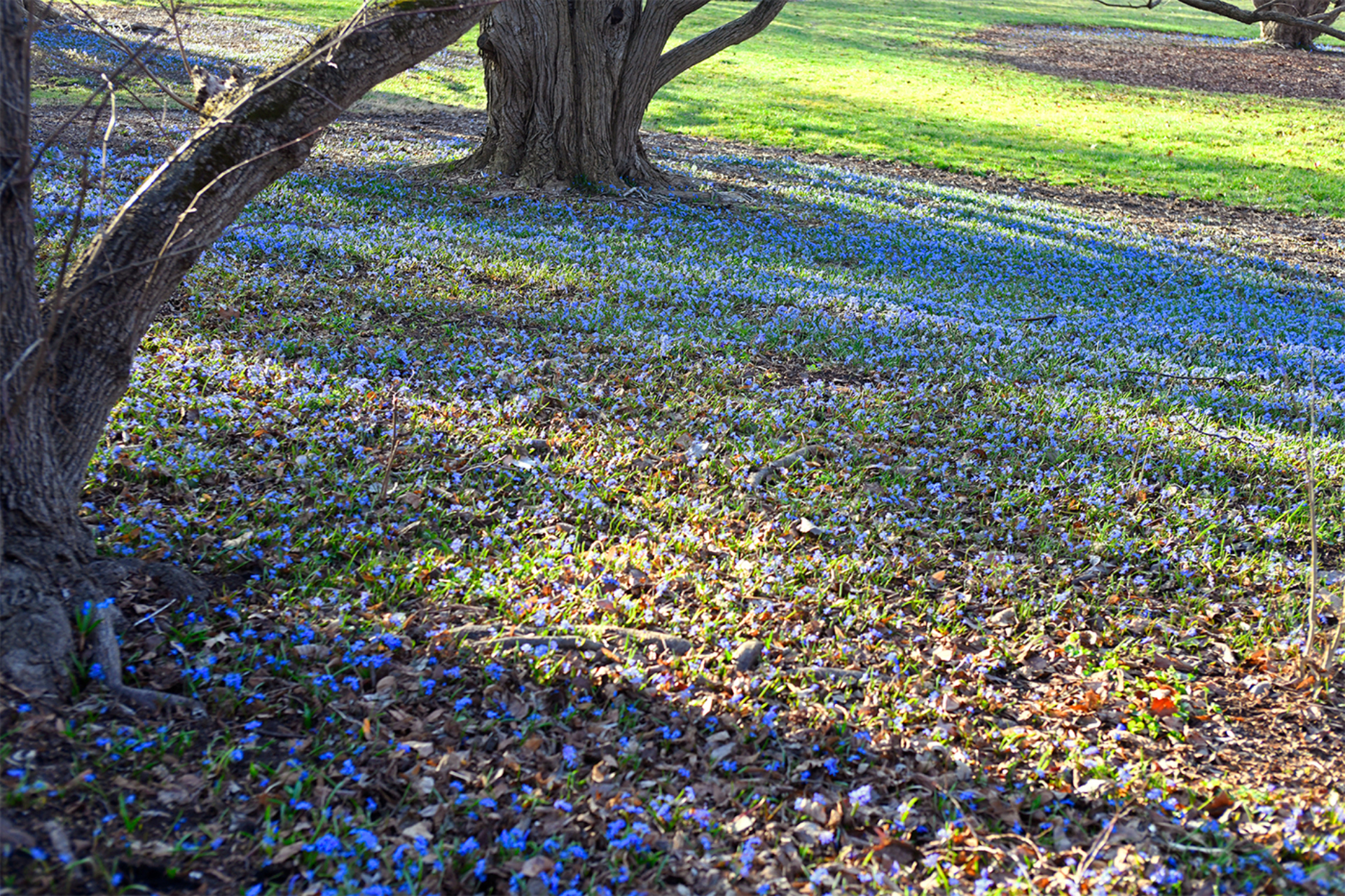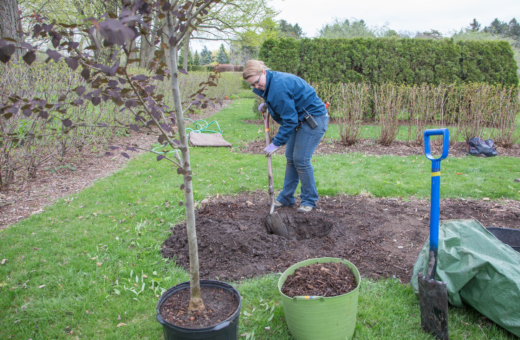March 19, 2024
Where is a good spot to see spring blooms at The Morton Arboretum? Everywhere, of course!
Drive along the Main Route between mid-March and mid-May, and you’ll see something new every day—a new clump of wildflowers beside the road, a new shade of green among the trees, the glitter of a pond in the woods where frogs are singing. Stop at any one of 33 parking lots and explore.
Many places at the Arboretum offer different kinds of spring flowers, some in the treetops and some along the ground, coming into bloom at different times. Remember that plants may bloom weeks earlier or later than usual, depending on each year’s weather. For example, this year is especially warm, and many plants are flowering early. Refer to the weekly Spring Bloom Report to see what has opened up, and check out the Hiking Map for walks as well as this list of Accessible Trails.
Here are a few suggestions for enjoying spring at the Arboretum.
On the East Side
Slider
Slider controls
Arbor Court. The open courtyard by the Visitor Center (Parking Lot 1) is surrounded by great trees and flowering shrubs, with beds and containers full of colorful flowers that are planted toward the end of March. They can inspire your own container planting, with tips given by Arboretum experts. The award-winning Children’s Garden is nearby, too.
Ground Cover Garden. Some of the Arboretum’s earliest blooms—witch-hazel, hellebores, Siberian squill—can be found in this secluded garden with a paved path just south of Arbor Court. Visit often to watch as spring’s delights unfold: fragrant viburnum, fern fiddleheads, dangling leaf buds opening on a weeping beech, daffodils, Virginia bluebells, and much more.
Dwarf Woody Plant Collection. This gathering of shrubs that are just the right size for home gardens includes many with lovely spring flowers and fragrances. It’s tucked away just east of the Firefly Pavilion, on a path that branches from the Conifer Walk. Head south from the Visitor Center, through The Gerard T. Donnelly Grand Garden plaza, and then turn left.
Magnolia Collection. The Arboretum’s renowned collection of magnolia trees is concentrated near Parking Lot 5 on the East Side. They are reached by a short trail that is covered in wood chips. The magnolias begin blooming sometime in March, depending on the weather, with huge flowers in shades of white, pink, red, and yellow. Visit them promptly, because these early blooms are vulnerable to late freezes and heavy rain. In early spring, listen for the spring peepers—tiny frogs singing in nearby Crowley Marsh.
East Woods. This natural area of woodland, dominated by oak trees, is laced with wood-chipped trails that wander among spring wildflowers and ephemeral ponds full of singing spring peepers. A prime wildflower walk is along Main Trail Loop 4 between Parking Lot 10 and the Big Rock Visitor Station at Parking Lot 13. You’ll see a succession of wildflowers, from the earliest sharp-lobed hepatica and bloodroot through several species of trillium to the last wild geraniums, phlox, and false rue-anemone. Sometime in late April or early May, there is a spectacular display of Virginia bluebells among the trees near Parking Lot 11. There is also a short paved trail at Big Rock Visitor Station.
Meadow Lake. The shoreline of this manmade lake, next to the Visitor Center, is planted with sweeps of native plants that sprout in springtime. One highlight is the pink fluffs of prairie smoke or old man’s whiskers, blooming near the paved path on the Visitor Center side, usually in early May.
Crabapple Collection. Dozens of crabapple varieties bloom in early May on a gentle hillside between parking lots 4 and 5. Look for a delightful array of pink, red, and white blooms sometime in late April to early May.
Slider
Slider controls
Sunfish Pond. One of the joys of early spring is not a sight but a sound: Thousands of chorus frogs in full voice, singing for mates in the wetland by Parking Lot 19, just west of the DuPage River. Take a wood-chipped trail that loops around by Sunfish Pond and the Europe Collection to enjoy the frog sound festival.
Joy Path. This paved path (with a significant slope) is just west of the Thornhill Education Center at Parking Lot 21. It runs south among splendid trees and beds of peonies and other perennials. At the top of the path, stop to enjoy the secluded Fragrance Garden.
Daffodil Glade. A sunlit glade beneath grand old oak trees is paved with daffodils starting sometime in late March or early April and continuing until May. It’s the most concentrated display of daffodils, although they can be found throughout the Arboretum. There are many varieties with a range of bloom times that prolong the show. To reach Daffodil Glade, continue straight along the main road past Thornhill Education Center.
Alternate Route. If, instead of proceeding to Daffodil Glade, you turn south along this road, you’ll find many charms, from snowdrops in late winter to early spring crocuses and later wildflowers. From Parking Lot 26, you can walk a wood-chipped trail to Daffodil Glade.
Witch-Hazel Dell. Just north of Lake Marmo, at Parking Lot 27, is a collection of the very earliest bloomers at the Arboretum: spring-blooming witch-hazel trees. Their yellow flowers open in late winter. The dell also includes the native fall-blooming witch-hazels, which usually flower in October.
Lake Marmo. In late April, when the redbud trees bloom, their lavender blossoms reflected in the lake’s still waters are a show-stopping sight. Park at Parking Lot 27 for a walk along a wood-chipped trail from Lake Marmo to Daffodil Glade and back.
Sterling Pond. Park at Parking Lot 28 and follow a wood-chipped trail to find this secluded pond, its shores often sparkling with wildflowers in spring.



